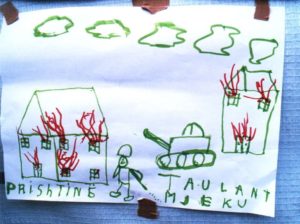 Treatments for traumatised refugees: more complex interventions needed
Treatments for traumatised refugees: more complex interventions needed
2 août 2017
Posted by Mina Fazel
This systematic review into psychosocial interventions for adult refugees (Tribe et al, 2017) is covering an increasingly important area.
The numbers forced to leave their homes as a result of organised violence are higher now than any time since the second world war (UNHCR, 2017). There are approximately 60 million displaced people in the world, of whom 22 million are currently refugees (having crossed an international border).
Epidemiological data consistently highlights the increased prevalence of mental health difficulties in refugee populations (see Mina’s previous blogs), although refugee populations are highly heterogenous having experienced a considerable range of different experiences and then, through various means of travel and exposures to insecurity, settle (either temporality or permanently) in a range of different post-migration contexts. The studies have thus far clearly highlighted the combined influences of exposure to previous traumatic events and post-migration stressors as having the greatest impact on mental health outcomes (Miller et al, 2010).

Worldwide, the number of people forced to leave their homes as a result of organised violence are higher now than any time since the second world war.
Methods
This review took a broad selection of intervention studies primarily investigating post-traumatic stress disorder (PTSD) although they included depression and anxiety in the outcomes of interest, yet these disorders were not included in their search terms. They searched four databases and only included English language studies.
They included clinic samples as well as RCTs of general population samples and to ensure as much data as possible was included, only studies with less than 10 participants were excluded.
Results
Of the 5,300 articles that were screened, 40 studies were included. These are presented in a table as well as described according to intervention type.
Narrative Exposure Therapy (NET) was the most empirically supported intervention and has been studied using lay counsellors as well as mental health professionals, providing an indication as to its potential scalability (Robjant et al, 2010). It is usually given in around 6-10 treatment sessions with a study reporting few sustained effects of brief (3 session) NET on refugees experiencing multiple traumatic events.
Eye Movement Desensitisation and Reprocessing (EMDR) had some data with limited overall evidence as 2 RCTs reported effectiveness and 2 reported no effects.
Culturally sensitive CBT was reported to be studied with good effects by one team in a clinic setting and standard CBT was studied in 2 RCTs with limited evidence to support its use.
A range of other interventions are reported including Trauma-Focused CBT interventions, multidisciplinary interventions and a range of other interventions.
The table below displays the studies with the largest numbers of participants.
Limitations
• As with many studies on refugee populations there is a difficulty to generalise findings given the many different sources of heterogeneity.
• Only English language studies were included and the search terms only looked at PTSD-related terms and not the range of psychological symptoms and disorders.
• The samples were often very different, most prominent were the studies reporting on outcomes from specialist clinic, such as a London trauma clinic, versus those in more general community settings, such as a refugee camp in Sub-Saharan Africa.
• Possible space limitations for the table might have forced some omissions, which might have been of use, such as the location of the study and although the studies were assessed according to a quality checklist, this data was not presented.
